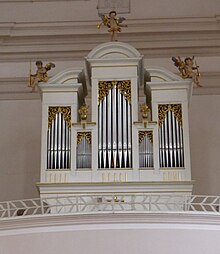Sebastian Church (Salzburg)
The Roman Catholic Sebastianskirche is a baroque church in Salzburg on Linzer Gasse , which belongs to the Inner Right Town or Neustadt . The church is structurally connected to the Sebastian cemetery and the St. Sebastian brother house . The patronage festival is celebrated on January 20th , Sebastiani .
history
The Sebastian Brotherhood had the first church built in the years 1500–1512 as a brotherhood church and consecrated in 1511 . At that time it was located outside the Salzburg city walls next to a plague cemetery, which is why it was dedicated to St. Sebastian , who was called especially when the plague occurred . The later remodeled church, which always functioned as a branch of St. Andrä , was rededicated in 1754. The town fire in 1818 badly affected the building, and a large ceiling fresco and the high altar painting , both by Paul Troger , were lost. The restoration of the church in a simplified form lasted until 1821. The church was damaged in an air raid on Salzburg, probably on November 22, 1944, in which the old brother house was hit, but could be restored by July 1945. From 1861–1898 and 1944–1952 it was a pastoral church for the parish of St. Andrä because no church was available at that time.
Today it is looked after by the St. Petrus FSSP Society, which runs the St. Sebastian Rectorate next door.
The church in its present form
The Sebastianskirche is a barrel-vaulted, late Baroque hall building, which was built between 1749 and 1753 according to plans by the master builder Kassian Singer (1712-1759). To the south of the church there is a facade tower that protrudes into Linzer Gasse and is crowned by an onion helmet with a lantern . The portals on the ground floor of the tower and in the presbytery were designed by Franz Anton Danreiter after 1750 . The bust of Saint Sebastian at the entrance is attributed to Josef Anton Pfaffinger . The figures on the consoles in the nave date from the middle of the 18th century and represent the hll. Andreas , Petrus and Paulus . The crucifix in the vestibule and the figure of a Mater Dolorosa come from Franz Seraphikus Nissl and were created around 1820.
The closing grille, forged in 1752, under the music-making gallery, into which iron roses, tendrils, vases and shells are woven, is impressive. With the final grille of the Peterskirche it is one of the main works of the artist Phillipp Hinterseer .
Furnishing
The high altar was created around 1750 and significantly revised after the great city fire in 1818. During this fire u. a. also the earlier altarpiece of Saint Sebastian lost. The statue of the Radiant Madonna and Child was created around 1610 and comes from the circle around Hans Waldburger .
The altar leaves on the front side altars show the Holy Family ( Johann Michael Sattler , 1821) and Maria Immaculata (Franz N. Streicher, around 1800). The altar leaves of the middle side altars (St. Donatus, St. Barbara) are by Sebastian Stief (1848), those of the rear side altars (St. Rochus, St. Florian) were painted in 1821 by Johann Michael Sattler.
The pulpit shows a representation of Moses on the sound cover, which was created around 1820.
organ
The organ is the work of Karl Mauracher (1789–1844), who completed it in 1829. It has a manual and pedal with 12 registers and is almost completely preserved. It is the first organ in the city of Salzburg to be equipped with a chromatic keyboard without a short octave .
Karl Mauracher became known indirectly for the dissemination of the Christmas carol Silent Night, Holy Night , which must have taken place between 1818 and 1829.
Disposition
|
|
||||||||||||||||||||||||||||
- Coupling : Pedal coupling (supplemented in 1864)
Chapel of St. Philip Neri
The older chapel attached to the church, which is consecrated to Saint Philip Neri , dates from 1684. It is located next to the short straight path through the church portal and the rear nave to the cemetery arcades. It has its own facade framed by Tuscan pilasters. The final grille of the chapel dates from the middle of the 18th century. Inside there is a small dome, the fresco of which Wolfram Schöberl created in 1956. The altarpiece of St. Philip Neri was designed by Sebastian Stief in the years after 1818. The chapel served as the family burial place of the city architect Bartolomä Bergamin.
Photos of the portal
Notes and individual references
- ^ Personnel status of the world and religious clergy of the Archdiocese of Salzburg for 1957 ( Schematismus 1957), ed. from the Archbishop's Office in Salzburg 1957, p. 150.
- ↑ 4th attack ; The air raids from the city of Salzburg . After simultaneous records and found Communications from the Municipal Statistical Office. In: Mitteilungen der Gesellschaft für Salzburger Landeskunde , No. 86/87, year 1946/47, p. 120.
- ^ Personnel status of the world and religious clergy of the Archdiocese of Salzburg for 1957 (Schematismus 1957), ed. from the Archbishop's Office in Salzburg 1957, p. 150.
- ↑ The first organ with a chromatic keyboard in the province of Salzburg (then the Duchy of Salzburg ) was created by Karl Mauracher in 1825 for the church of St. Nikolaus von Oberndorf , which has since been demolished , and where Franz Xaver Gruber was organist from 1816–1829. Compare: Gerhard Walterskirchen : Organs and Organ Builders in Salzburg from the Middle Ages to the Present . Dissertation, Salzburg 1982, p. 266 .
literature
- Lieselotte von Eltz-Hoffmann: The churches of Salzburg. Verlag Anton Pustet, Salzburg 1993, ISBN 3-7025-0308-0
- Bernd Euler, Ronald Gobiet, Horst Huber: Dehio Salzburg - City and Country. Verlag Anton Schroll & Co., Vienna 1986, ISBN 3-7031-0599-2
Web links
Coordinates: 47 ° 48 ′ 15 " N , 13 ° 2 ′ 52" E







